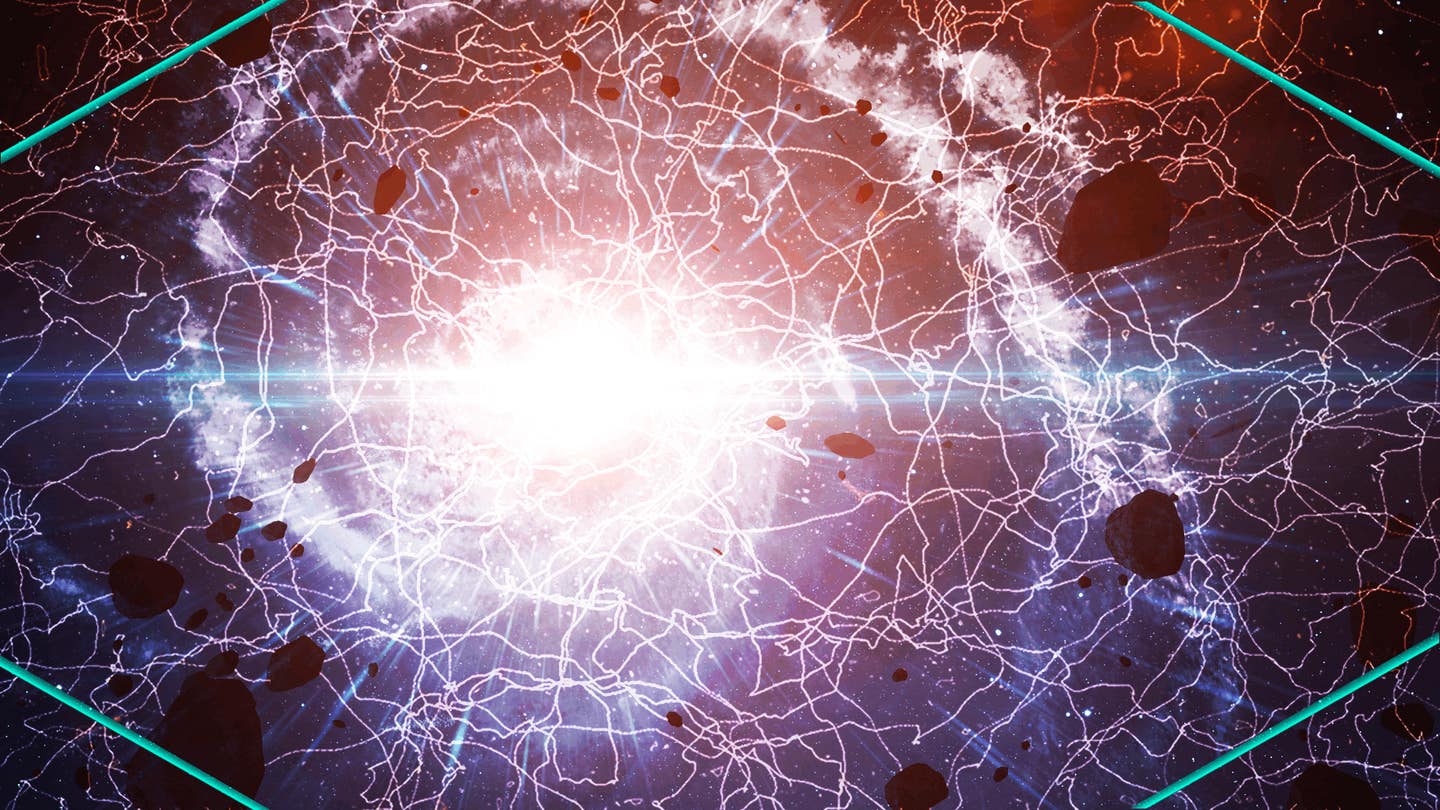First-ever cosmic string discovery revealed by scientists
Cosmic strings are hypothetical topological defects, often described as “cracks” in the universe, that formed following the Big Bang.

Cosmic strings are hypothetical topological defects, often described as “cracks” in the universe, that theoretically formed during the quantum chaos immediately following the Big Bang. (CREDIT: CC BY-SA 4.0)
The universe, as we understand it, commenced from a singularity point in an explosive event known as the Big Bang, an occurrence so vast and fundamentally transformative that it challenges the very limits of human comprehension.
Within a fraction so minute, a one-hundredth of a second following this colossal explosion, scientists propose that the early universe underwent an incredible phase change within its quantum field. This transition, analogically akin to the bubbling formation in water as it reaches its boiling point—albeit occurring at exponentially higher temperatures—may have been the crucible for one of the most enigmatic and elusive structures hypothesized in cosmology: cosmic strings.
Cosmic strings, or CS, are theoretical one-dimensional topological defects in the fabric of space-time, conjectured to have formed amid the tumultuous conditions prevalent in the early universe's phase transitions.
These hypothetical entities, first proposed in the scientific discourse of the 1970s, have tantalized and evaded researchers for decades. Initial searches for tangible evidence of cosmic strings pivoted on investigations into the Cosmic Microwave Background (CMB)—the faint echo of the Big Bang's radiation. Yet, these searches were met with the cold void of space, yielding no affirmative data.
The cosmic string hypothesis, somewhat sidelined after the initial excitement and subsequent disappointment, experienced a renaissance in the early 21st century through its intriguing connections with String Theory.
Advocates of this interdisciplinary approach postulated that cosmic strings, if detectable, could serve as observational signatures for the high-dimensional vibrations postulated by String Theory, thereby offering a unique peephole into the yet-unsubstantiated realms of this theoretical framework.
In this context, the recent announcement from the Indian Institute of Astrophysics has sent ripples through the scientific community.
Related Stories
Last month, the institute's researchers publicized the identification of several persuasive cosmic string candidates, with one specific field of space, designated as CSc-1, drawing particular interest.
Their findings, while still awaiting peer review, have been preliminarily published in the Bulletin de la Société Royale des Sciences de Liège and are accessible on the arXiv preprint server.
The focal point of this groundbreaking study is an enigmatic duo of bright galactic entities cataloged as SDSSJ110429.61+233150.3. These celestial bodies, initially perceived as a pair of separate galaxies, are postulated by the research team to be a single galaxy, its image cleaved into two distinct components due to a phenomenon known as gravitational lensing.
This process, where the gravitational fields exerted by massive celestial bodies distort and bifurcate the light from objects behind them, is typically associated with the immense gravitational pull of galaxy clusters. However, in this instance, the researchers propose a different lensing agent: a cosmic string.
In the study, the team found, "The significant correlation between the spectra of the two components indicates the possible GL (gravitational lensing) nature of the pair. Our simulations of observational data in the CSc-1 field shows that a large number of pairs can be explained by the complex geometry of the CS (cosmic string)."
They further discuss their simulations of the SDSSJ110429 galaxy pair, revealing, "The observed angle between the components of the pair can be explained if the CS is strongly inclined and, possibly, bent in the image plane."
This hypothesis, while compelling, carries its share of uncertainties, largely due to the unprecedented nature of the findings. Cosmic strings, if they exist, represent remnants from the universe's infancy, and no concrete evidence of such primordial defects has been previously documented.
The researchers, therefore, proceed with scientific prudence. They recognize the possibility that the absence of detectable mass between the “twinned” galaxies could suggest that they are indeed separate entities. Nonetheless, the identical nature of the light spectra from the two components bolsters the argument for their being duplicates, resulting from the gravitational influence of a cosmic string.
In pursuit of further clarity and potentially irrefutable evidence, the scientists recommend an intensive examination of the CSc-1 field, employing the advanced capabilities of a 4-meter class telescope. One such observatory, the Devasthal Optical Telescope, situated in Nainital, India, could play a crucial role in this investigative endeavor.
While the study stops short of providing the unequivocal evidence that astrophysicists have been zealously seeking for over fifty years, it marks a potentially significant milestone in our cosmic quest.
The journey to understanding cosmic strings is akin to threading a needle in the dark expanse of space; the task is meticulous, the target elusive, and the implications profound.
Whether these findings will solidify into the long-sought proof of cosmic strings' existence or dissolve into the cosmic background remains to be seen. However, the pursuit of such knowledge underscores humanity's relentless quest to decipher the universe's deepest mysteries and the fundamental forces that shape the very fabric of our existence.
Note: Materials provided above by The Brighter Side of News. Content may be edited for style and length.
Like these kind of feel good stories? Get The Brighter Side of News' newsletter.
Joseph Shavit
Science News Writer, Editor-At-Large and Publisher
Joseph Shavit, based in Los Angeles, is a seasoned science journalist, editor and co-founder of The Brighter Side of News, where he transforms complex discoveries into clear, engaging stories for general readers. With experience at major media groups like Times Mirror and Tribune, he writes with both authority and curiosity. His work spans astronomy, physics, quantum mechanics, climate change, artificial intelligence, health, and medicine. Known for linking breakthroughs to real-world markets, he highlights how research transitions into products and industries that shape daily life.
